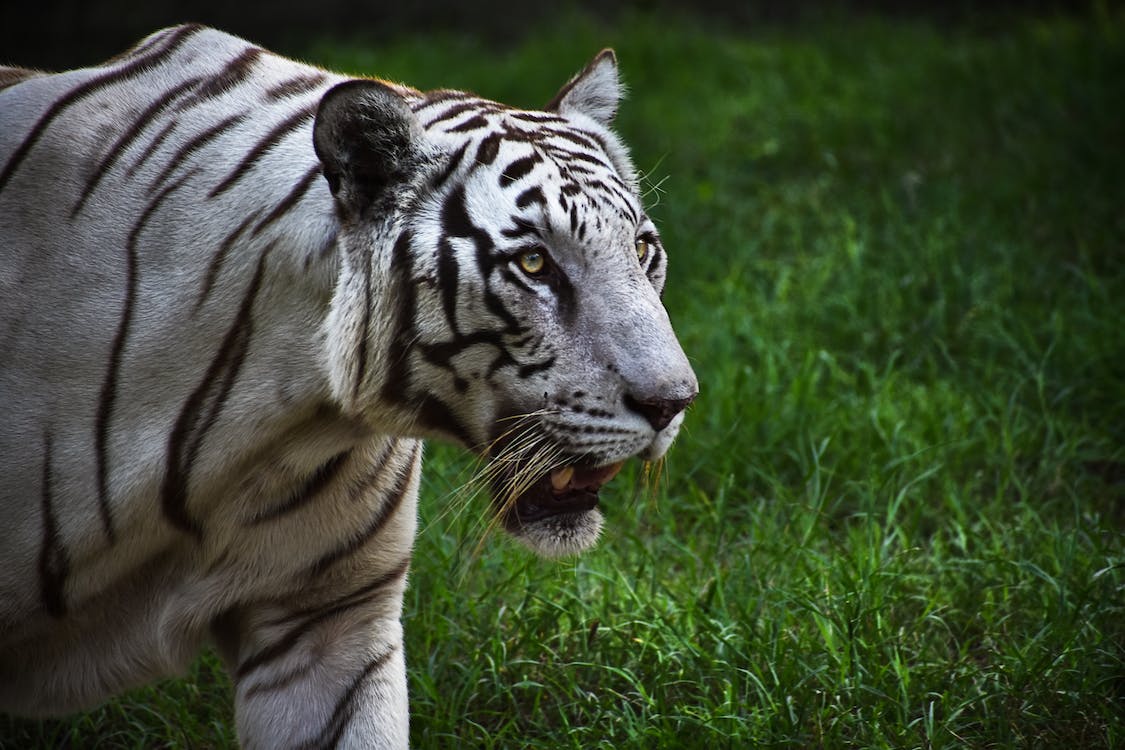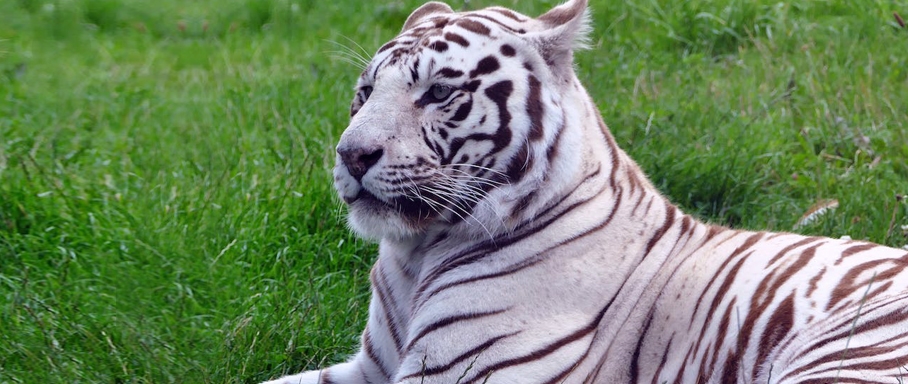White tigers are some of the most beautiful animals on Earth. But despite their beauty, the truth is that they’re incredibly rare. That’s because they’re a result of a genetic mutation in Bengal tigers. [1] While every Bengal tiger carries the gene for the white fur, both parents have to carry the gene and pass it on to their offspring for it to be completely white.
Have you ever dreamed of seeing a white tiger in its natural habitat? If so, you’re not alone. White tigers are one of nature’s most rare, beautiful, and majestic creatures that many people find themselves drawn to. But just how rare are white tigers? And what are the chances of finding one in the wild? To understand all of this, you must first understand what exactly a white tiger is and how it became so rare.
What is a White Tiger?
A white tiger is a subspecies of a Bengal tiger, which is found primarily in India. It differs from its regular Bengal tiger relatives in its distinctive white fur, black stripes, and blue eyes. These animals mostly reside in captivity, as they are incredibly rare in the wild. [2]
Physical Characteristics and Behaviors
The physical characteristics of a white tiger remain largely consistent with other tigers. They are large cats that weigh between 400 and 500 pounds and can measure up to 10 feet long. They are recognizable by their white fur, black stripes, and blue eyes.
As for behaviors, white tigers prefer to be alone and do not usually engage in social activities with other members of their species. [3] This makes it very difficult to breed them in captivity in order to sustain their population.
The History of the White Tiger
The origins of the white tiger are shrouded in mystery. It is believed that their unique color is the result of two recessive genes passed down through generations of Bengal tigers. The first white tigers were discovered in India in the early 1950s and have been intensely studied since then.
Why are They Different and Rare?
Since their white coat is the result of two recessive genes coming together, theoretically, when two Bengal tigers with the recessive gene are bred together, the chances of a white cub being born increases dramatically. Unfortunately, in practice, many litters produced through this method do not contain any white cubs.
Furthermore, the cubs produced this way are weak with various health issues due to inbreeding. Hence, because of the unfavorable results, breeding these animals can be an expensive and arduous task for zoos and conservationists.
Health Problems
White tigers often suffer from health complications due to their genetics. One common ailment is crossed-eyes (strabismus). [4] This condition occurs when both eyes do not focus on the same point, at the same time. In addition to crossed-eyes, white tigers may also have various malformations or genetic diseases that significantly shorten their lifespan in comparison to regular Bengal tigers.
How Rare Are White Tigers?
Given that white tigers are produced through breeding two Bengal tigers with a recessive gene, their rarity cannot be overstated enough. This gene is susceptible to being lost through generations. Plus, when two white tigers are bred together, there is always a chance that their offspring will still possess one or two regular Bengal genes and turn out to look like their regular relatives. Thus, it is becoming increasingly unlikely for two purebred white parents to produce a litter of cubs at any given time due to their scarcity in comparison to regular Bengal tigers.
How Rare Are White Tigers in the Wild?
In terms of wild populations, conservationists estimate that there are only around 200 surviving wild white tigers in the whole world. [5] Their numbers have decreased significantly since they were first discovered in India in 1951. Many were hunted for sport or poached for their fur before conservation efforts stepped in to protect them from extinction. Sadly enough, this number still continues to dwindle as many regions where these animals once roamed have now been taken over by humans for agriculture and other development activities, leaving them with less suitable habitats for survival.
Legislation Against Exploitation Of White Tiger

Given how rare these animals are, it is important to take proper safety measures to protect them from exploitation or abuse. This species remains extremely vulnerable due to their limited numbers and selectively bred ancestry.
Many countries have enforced laws banning any sort of entertainment industry use of these magnificent creatures. You won’t find them in circus shows or petting zoos. This is because many establishments have been reported to use cruel means, such as drugs or electric shock collars, to force compliance from tigers during performances. Because of their solitary behavioristic traits mentioned earlier, white tigers may not be naturally inclined towards performing any tricks for humans.
In addition, several regulations have also been put into place for zoos that would like to house these animals. These regulations ensure that this rare animal receives proper care and nutrition and protects it from accidental illegal trade. As most people consider these creatures valuable trophies due to their rarity, they are even more vulnerable without proper safety precautions by governing bodies worldwide.
Odds of Finding a White Tiger in the Wild
White is a bad color to have when you are trying to hunt in the wild. That’s the main reason only a very few white tigers survive in the wild. The odds of a white tiger being born in the wild are about 1 in 10,000. In fact, Sumatran tigers are number 3 on the “10 Most Endangered Animals” list [6], with an estimated 600 tigers surviving. As for white tigers, there are only 200 with most living in captivity. [7]
The odds of finding a white tiger in the wild is a difficult statistic to pinpoint as they are extremely rare and don’t usually survive in the wild due to their color and other genetic conditions.
White tigers are actually Bengal tigers that carry a recessive gene that causes the white coloring; unfortunately this gene is very rare and hard to replicate naturally in the wild. To put things into perspective: with approximately 4,500 tigers living in the wild today, [8] there are only a few known locations where it’s possible to find white tigers. So you can see how incredibly slim the chance of encountering one is.
Rarity and Natural Occurrence of White Tigers
In order for two Bengal tigers to produce a white cub, both parents must carry the unique recessive gene causing the offspring to be white. This process must be repeated over multiple generations to form an entire population of white tigers, an incredibly challenging task. Additionally, white tigers usually do not survive well in the wild due to various health issues. For example, white tigers as have poor eyesight because their eye color depends on their coat color. However, some organizations are working hard to increase survival rates and establish populations of white tigers in safe enclosures.
Historical Data and Documented Sightings
The first recorded sighting of a wild white tiger dates back to the early 19th. Since then, there have been several other sightings in different parts of India but none of these instances have produced further offspring or given rise to large populations of white tigers outside of captivity.
Geographic Locations with Higher Chances of White Tiger Sightings
The chances of spotting a white tiger during a safari are incredibly slim. However, there are certain locations where you may have better luck than others, thanks to ongoing efforts made by conservationists and government organizations such as Rewa Zoo. The potential areas worth checking out include Madhya Pradesh, Assam, West Bengal, Bihar, Odisha, in the Sunderbans region and especially in the former State of Rewa.
Did You Know? – Interesting Facts About White Tigers
- White Tigers are also known as bleached tigers.
- They belong to the subspecies Panthera tigris.
- They can grow up to 10 feet long and usually have blue eyes.
- White tigers live an average lifespan of 10 to 15 years.
- The white coat lowers their chances of survival because it doesn’t provide a camouflage.
- Most of them are born with poor eyesight.
- White tigers are solitary beings. They are territorial and prefer being alone.
- They are capable swimmers.
Conclusion
White tigers are some of nature’s most captivating creatures. So captivating that many people try their luck hoping to catch a glimpse during safaris or trips around the world. But due to their rarity and lack of natural occurrence, the chances of spotting one in the wild are extremely slim. The more practical solution is to get closer to one in a zoo and there are many zoos around the world that had or have a white tiger in captivity (most zoos have stopped breeding white tigers). These include San Diego Zoo, Wildlife World Zoo Arizona, Singapore Zoo , Delhi Zoo and Beijing Zoo.
References
- The truth about white tigers. (n.d.). World Wildlife Fund. https://www.worldwildlife.org/stories/the-truth-about-white-tigers
- White tiger. (n.d.). Encyclopedia Britannica. https://www.britannica.com/animal/white-tiger-mammal
- Chief, F. (2022, January 12). White tiger facts. Facts.net. https://facts.net/white-tiger-facts/
- Convergent strabismus in a white Bengal tiger. (1999, March). PubMed. https://pubmed.ncbi.nlm.nih.gov/10197239/
- Dueck, K. (2022, October 12). How many white tigers are left in the world? AZ Animals. https://a-z-animals.com/blog/how-many-white-tigers-are-left-in-the-world/
- 10 of the world’s most endangered animals. (2022, April 7). WWF. https://www.wwf.org.uk/learn/wildlife/endangered-animals
- Dueck, K. (2022, October 12). How many white tigers are left in the world? AZ Animals. https://a-z-animals.com/blog/how-many-white-tigers-are-left-in-the-world/
- Munson, O., & TODAY, U. (2023, April 12). How many tigers are left in the world? The status of tiger populations. USA TODAY. https://www.usatoday.com/story/news/2023/04/12/how-many-tigers-left-world/11600984002/

